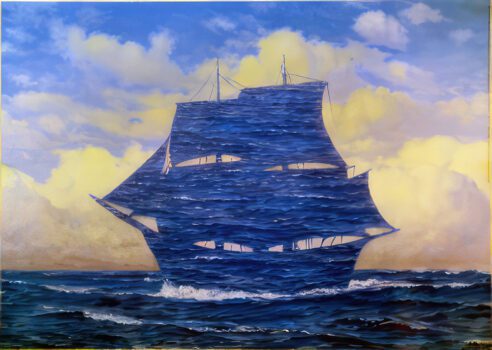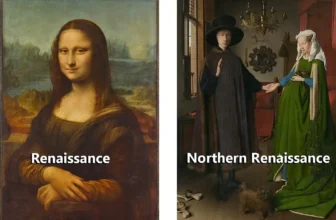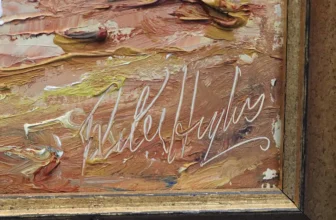Meaning of “The Seducer” Painting by René Magritte
René Magritte, one of the most enigmatic and beloved figures of the Surrealist movement, was a master of painting mystery into the mundane. Among his many works, “The Seducer” (Le Séducteur) stands out as a particularly poetic and dreamlike vision, one that continues to seduce the imagination of art lovers and scholars alike.
Painted in 1950, “The Seducer” is a hauntingly quiet yet profoundly symbolic piece that seems simple on the surface, yet unfolds layers of philosophical inquiry, dream logic, and existential questioning the more one peers into it. The painting showcases Magritte’s gift for combining familiar imagery in ways that provoke the unconscious, a hallmark of Surrealism.
This piece aims to offer a comprehensive exploration of “The Seducer”, its visual elements, how it was painted, what it represents, its symbolic undertones, and what makes it a quintessential Magritte creation.
What’s Happening in “The Seducer”?
At first glance, “The Seducer” portrays a strikingly serene seascape: a calm sea under a peaceful sky, rendered in rich, deep blues. The central figure is a fully rigged ship, a classic, old-fashioned sailboat, floating not on the sea, but as the sea. Instead of the ship’s hull, we see an uncanny cut-out shape of a ship, filled entirely with the same sea texture and color as the surrounding ocean. The ship, in a sense, is transparent, but more accurately, it is made of the sea itself.
This visual paradox, of a ship formed entirely of water, stuns the viewer into contemplation. It defies physical logic, yet feels oddly appropriate, as if it belongs perfectly in this dreamlike realm.
The sky is clear, the horizon subtle, and there is no human presence or narrative action, just this ghostly ship that appears to emerge from, or dissolve into, the ocean around it. It is a scene at once peaceful and unnerving.
How “The Seducer” Was Created
Magritte’s painting technique was characterized by precision, restraint, and almost photorealistic clarity. He avoided the wild brushstrokes and abstraction common in much modern art of his time. Instead, he employed a tight, illustrative style, one more akin to commercial advertising art, in which he was trained early in his career.
In “The Seducer,” Magritte painted in oil on canvas, using cool tones of blue and gray, with exacting attention to detail in the depiction of water and sky. The ship’s form is perfectly symmetrical and classically proportioned, and the gentle ripples of the ocean within the silhouette are meticulously painted to match the surrounding sea.
It is this juxtaposition of surreal imagery with realistic technique that creates such cognitive dissonance. The viewer sees something impossible, rendered in a style that suggests photographic truth. This tension between appearance and reality is central to Magritte’s approach.
Surrealism and the Seduction of Thought
To understand the meaning of “The Seducer,” one must appreciate the principles of Surrealism, the avant-garde movement with which Magritte was closely associated. Surrealism, emerging in the 1920s, sought to unleash the unconscious mind and challenge the constraints of rationalism and logic. Inspired by the works of Sigmund Freud, Surrealist artists and writers pursued dreams, paradoxes, and visual puns as a way to access deeper truths.
Magritte’s particular brand of Surrealism was more cerebral than emotional. Unlike Salvador Dalí’s melting clocks or André Breton’s automatic writing, Magritte approached the irrational with a cool, philosophical detachment. He aimed to “make thought visible”, to create images that disturbed not the emotions, but the assumptions of perception.
“The Seducer” is a perfect example of this methodology. By blending a ship and sea into a single entity, Magritte presents us with an image that is both familiar and impossible, leading the viewer into a state of cognitive instability, and poetic wonder.
The Symbolism of “The Seducer”
So, what does this water-ship really symbolize?
The painting’s title, “The Seducer,” provides a tantalizing clue. A seducer is someone who entices or lures, often by deception or illusion. In this sense, the ship made of water could be seen as a metaphor for illusion itself, a vessel that promises movement or escape but is, in fact, made of the same material from which it is meant to depart.
Several layers of symbolism are at play here:
1. Illusion and Identity
The ship, an object usually distinct from the sea, is now indistinguishable from it. This challenges the very idea of separateness, of identity. Is the ship of the sea, or is it merely a void? If it is indistinct, does it exist? Here Magritte toys with the philosophical notion of being and non-being, a theme that recurs throughout his work.
2. Desire and Disappointment
The ship is a classic symbol of journey, escape, and adventure. But this ship is made of water, it cannot sail. It is a mirage, a longing that cannot be fulfilled. Thus, “The Seducer” becomes an emblem of unattainable desire, a dream of movement frozen in paradox.
3. Reflection on Art Itself
The painting also functions as a meta-commentary on representation. Magritte was obsessed with how images convey, or fail to convey, reality. The ship here is not a ship, but a hole in the sea shaped like one. Is this not the nature of all painting, illusion masquerading as form?
This layered symbolism is what makes “The Seducer” such a compelling object of analysis. Each interpretation flows into the next, like the sea itself.
Who or What is the Seducer?
The title “Le Séducteur” introduces a psychological dynamic into an otherwise still and silent scene. Is the ship the seducer? Or is the sea? Is the seduction about drawing the viewer into a false sense of understanding, only to subvert it?
One compelling reading is that the painting itself is the seducer. It invites us in with beauty and calm, the tranquil sea, the romantic ship, but as we look closer, we realize we are being tricked. The ship cannot sail. The journey is an illusion. And yet we are compelled to keep looking.
This interplay between desire and deception, invitation and impossibility, lies at the heart of the painting’s seductive power.
Magritte’s Broader Themes: Echoes Across His Work
“The Seducer” shares conceptual DNA with many of Magritte’s other works. He often used visual substitutions and overlays to create paradoxes:
In “The False Mirror”, an eye becomes the sky.
In “The Human Condition”, a painting inside a painting becomes indistinguishable from the real landscape.
In “The Treachery of Images”, a pipe is accompanied by the phrase “This is not a pipe.”
Each of these works plays with the boundary between representation and reality, between what we think we see and what we are actually seeing. “The Seducer” continues this thread by embedding illusion into form itself.
Art Style and Classification
“The Seducer” falls squarely within the domain of Surrealism, but also touches upon Magritte’s own unique style, sometimes referred to as Magic Realism or Conceptual Realism.
Unlike the distorted forms of Dalí or the abstract biomorphs of Miró, Magritte painted with clarity and directness. This gives his work a peculiar tension, ordinary things made extraordinary by context and substitution.
In this painting, the elements are realistic: the sea, the ship, the sky. But their combination creates a new, irrational reality. This balance between realism and surrealism defines Magritte’s enduring aesthetic.
Where is “The Seducer” Painting Today?
As of today, “The Seducer” (1950) resides in the Israel Museum in Jerusalem, which holds a significant collection of modern and contemporary art. The museum acquired the piece as part of its commitment to preserving and presenting Surrealist masterpieces.
This adds another layer of intrigue to the painting, its journey across time and geography, from the Belgian studio of Magritte to the heart of the Middle East, echoing the ship motif and its promise of faraway destinations.
“The Seducer” is not among Magritte’s most famous works, yet it holds a cherished place in the hearts of those who encounter it. Its imagery has appeared in book covers, philosophical essays, and even pop culture references.
Why? Because it captures something universal yet elusive: the tension between reality and dream, between appearance and truth. Like the best art, it does not provide answers. It asks questions, ones that linger long after we’ve walked away.
The Power of Mystery
In “The Seducer,” René Magritte offers us no grand narrative or overt symbolism. Instead, he presents an image that is quietly disorienting, tenderly absurd. The ship made of sea, floating in still water, suggests a universe where form and content, desire and illusion, self and other, are not as fixed as we believe.
It is a painting that seduces the intellect as much as the eye, beckoning us into a space of poetic reflection.
Like all great Surrealist art, “The Seducer” does not tell us what to think. Instead, it asks us to feel the strangeness of being, and to embrace the uncertainty at the heart of seeing.
It is, perhaps, the ultimate seduction.




